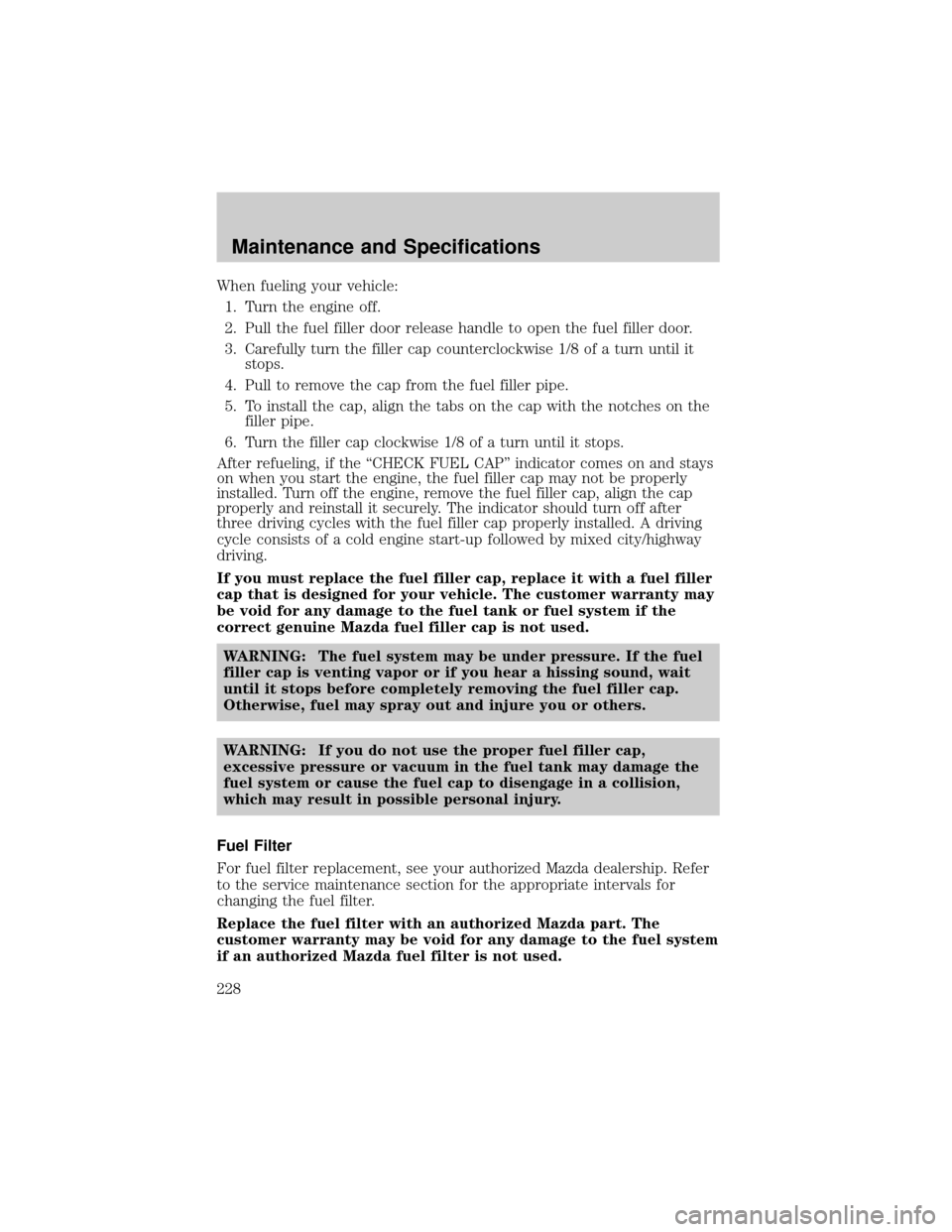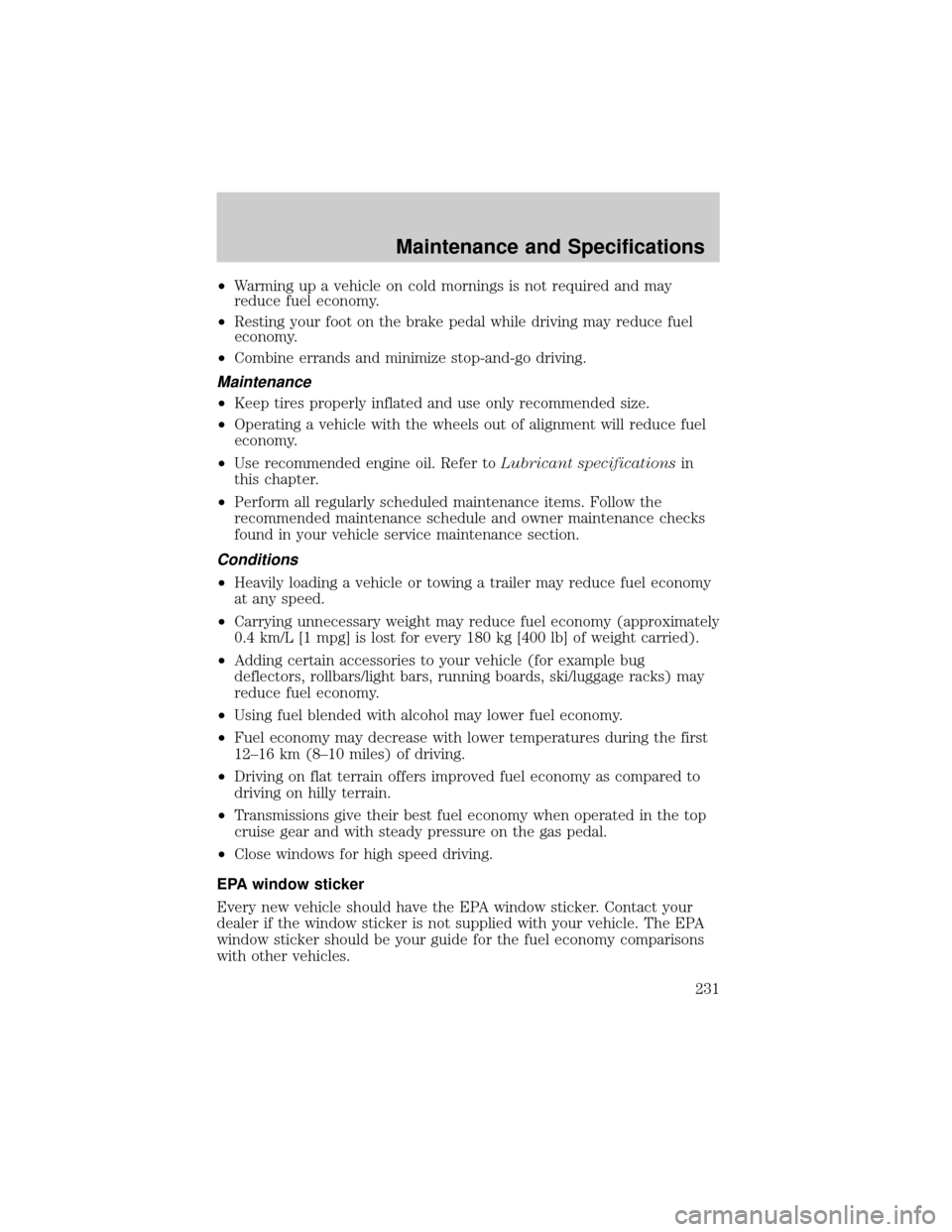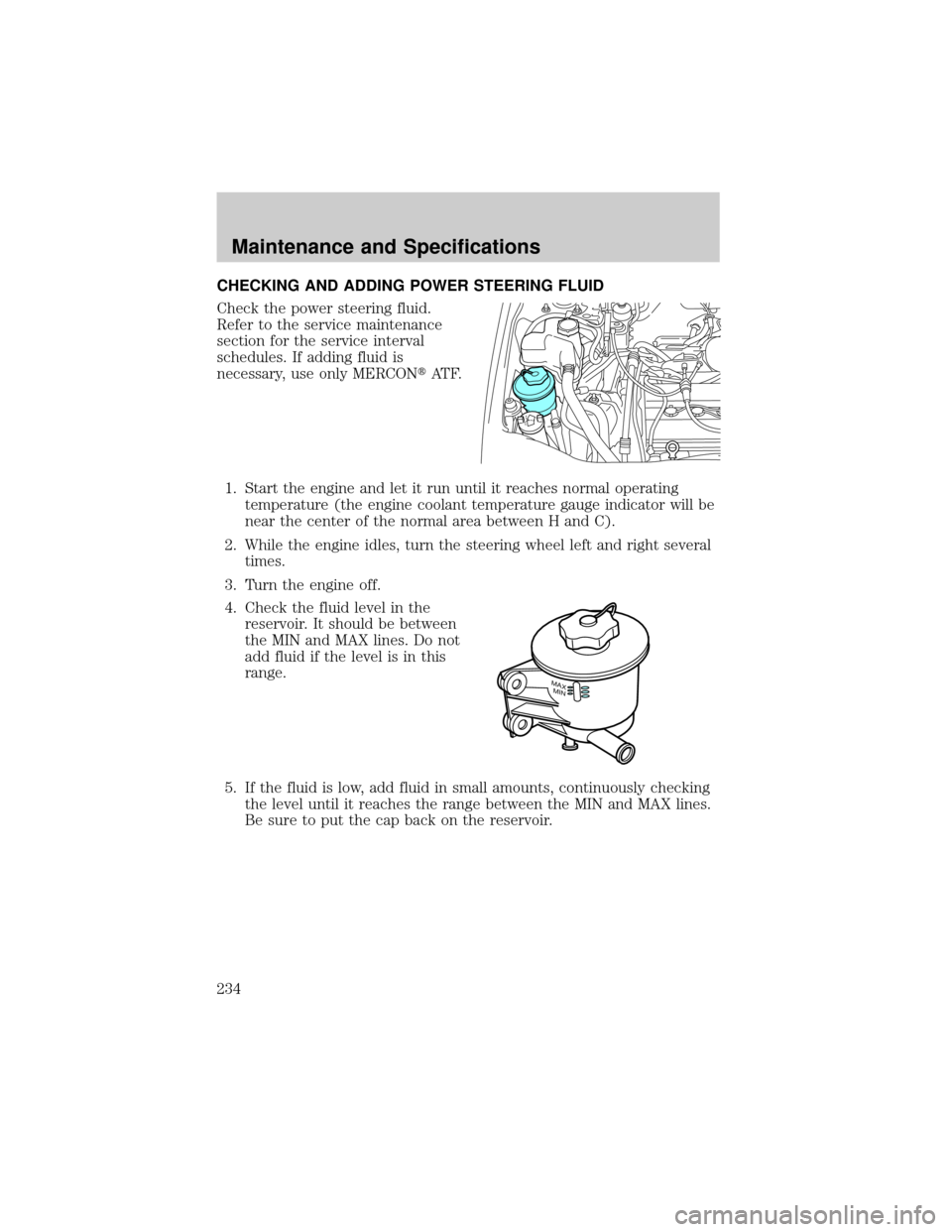check engine MAZDA MODEL TRIBUTE 2002 (in English) Owner's Manual
[x] Cancel search | Manufacturer: MAZDA, Model Year: 2002, Model line: MODEL TRIBUTE, Model: MAZDA MODEL TRIBUTE 2002Pages: 256, PDF Size: 2.66 MB
Page 227 of 256

ªRegularº unleaded gasoline. ªPremiumº unleaded gasoline is not
recommended (particularly in the United States) because it may cause
these problems to become more pronounced. If the problems persist, see
your authorized Mazda dealer.
It should not be necessary to add any aftermarket products to your fuel
tank if you continue to use high quality fuel of the recommended octane
rating.
Aftermarket products could cause damage to the fuel system.
Repairs to correct the effects of using an aftermarket product in
your fuel may not be covered by your warranty.
Many of the world's automakers
issued the World-wide Fuel Charter
that recommends gasoline
specifications to provide improved
performance and emission control
system protection for your vehicle.
Gasolines that meet the World-wide
Fuel Charter should be used when
available. Ask your fuel supplier
about gasolines that meet the
World-wide Fuel Charter. In Canada,
look for fuels that display theAuto Makers' Choiceylogo.
Cleaner air
Mazda endorses the use of reformulated ªcleaner-burningº gasolines to
improve air quality.
Running out of fuel
Avoid running out of fuel because this situation may have an adverse
affect on powertrain components.
If you have run out of fuel:
²You may need to cycle the ignition from OFF to ON several times after
refueling, to allow the fuel system to pump the fuel from the tank to
the engine.
²The
indicator may come on. For more information on the ªCheck
Engineº indicator, refer to theInstrument Clusterchapter.
Fuel Filler Cap
Your fuel tank filler cap has an indexed design with a 1/8 turn on/off
feature.
Maintenance and Specifications
227
Page 228 of 256

When fueling your vehicle:
1. Turn the engine off.
2. Pull the fuel filler door release handle to open the fuel filler door.
3. Carefully turn the filler cap counterclockwise 1/8 of a turn until it
stops.
4. Pull to remove the cap from the fuel filler pipe.
5. To install the cap, align the tabs on the cap with the notches on the
filler pipe.
6. Turn the filler cap clockwise 1/8 of a turn until it stops.
After refueling, if the ªCHECK FUEL CAPº indicator comes on and stays
on when you start the engine, the fuel filler cap may not be properly
installed. Turn off the engine, remove the fuel filler cap, align the cap
properly and reinstall it securely. The indicator should turn off after
three driving cycles with the fuel filler cap properly installed. A driving
cycle consists of a cold engine start-up followed by mixed city/highway
driving.
If you must replace the fuel filler cap, replace it with a fuel filler
cap that is designed for your vehicle. The customer warranty may
be void for any damage to the fuel tank or fuel system if the
correct genuine Mazda fuel filler cap is not used.
WARNING: The fuel system may be under pressure. If the fuel
filler cap is venting vapor or if you hear a hissing sound, wait
until it stops before completely removing the fuel filler cap.
Otherwise, fuel may spray out and injure you or others.
WARNING: If you do not use the proper fuel filler cap,
excessive pressure or vacuum in the fuel tank may damage the
fuel system or cause the fuel cap to disengage in a collision,
which may result in possible personal injury.
Fuel Filter
For fuel filter replacement, see your authorized Mazda dealership. Refer
to the service maintenance section for the appropriate intervals for
changing the fuel filter.
Replace the fuel filter with an authorized Mazda part. The
customer warranty may be void for any damage to the fuel system
if an authorized Mazda fuel filter is not used.
Maintenance and Specifications
228
Page 231 of 256

²Warming up a vehicle on cold mornings is not required and may
reduce fuel economy.
²Resting your foot on the brake pedal while driving may reduce fuel
economy.
²Combine errands and minimize stop-and-go driving.
Maintenance
²Keep tires properly inflated and use only recommended size.
²Operating a vehicle with the wheels out of alignment will reduce fuel
economy.
²Use recommended engine oil. Refer toLubricant specificationsin
this chapter.
²Perform all regularly scheduled maintenance items. Follow the
recommended maintenance schedule and owner maintenance checks
found in your vehicle service maintenance section.
Conditions
²Heavily loading a vehicle or towing a trailer may reduce fuel economy
at any speed.
²Carrying unnecessary weight may reduce fuel economy (approximately
0.4 km/L [1 mpg] is lost for every 180 kg [400 lb] of weight carried).
²Adding certain accessories to your vehicle (for example bug
deflectors, rollbars/light bars, running boards, ski/luggage racks) may
reduce fuel economy.
²Using fuel blended with alcohol may lower fuel economy.
²Fuel economy may decrease with lower temperatures during the first
12±16 km (8±10 miles) of driving.
²Driving on flat terrain offers improved fuel economy as compared to
driving on hilly terrain.
²Transmissions give their best fuel economy when operated in the top
cruise gear and with steady pressure on the gas pedal.
²Close windows for high speed driving.
EPA window sticker
Every new vehicle should have the EPA window sticker. Contact your
dealer if the window sticker is not supplied with your vehicle. The EPA
window sticker should be your guide for the fuel economy comparisons
with other vehicles.
Maintenance and Specifications
231
Page 234 of 256

CHECKING AND ADDING POWER STEERING FLUID
Check the power steering fluid.
Refer to the service maintenance
section for the service interval
schedules. If adding fluid is
necessary, use only MERCONtAT F.
1. Start the engine and let it run until it reaches normal operating
temperature (the engine coolant temperature gauge indicator will be
near the center of the normal area between H and C).
2. While the engine idles, turn the steering wheel left and right several
times.
3. Turn the engine off.
4. Check the fluid level in the
reservoir. It should be between
the MIN and MAX lines. Do not
add fluid if the level is in this
range.
5. If the fluid is low, add fluid in small amounts, continuously checking
the level until it reaches the range between the MIN and MAX lines.
Be sure to put the cap back on the reservoir.
MAXMIN
Maintenance and Specifications
234
Page 236 of 256

TRANSMISSION FLUID
Checking automatic transmission fluid
Refer to your scheduled maintenance section for scheduled intervals for
fluid checks and changes. Your transaxle does not consume fluid.
However, the fluid level should be checked if the transaxle is not working
properly, i.e., if the transaxle slips or shifts slowly or if you notice some
sign of fluid leakage.
Automatic transmission fluid expands when warmed. To obtain an
accurate fluid check, drive the vehicle until it is warmed up
(approximately 30 km [20 miles]). If your vehicle has been
operated for an extended period at high speeds, in city traffic
during hot weather or pulling a trailer, the vehicle should be
turned off for about 30 minutes to allow fluid to cool before
checking.
1. Drive the vehicle 30 km (20 miles) or until it reaches normal
operating temperature.
2. Park the vehicle on a level surface and engage the parking brake.
3. With the parking brake engaged and your foot on the brake pedal,
start the engine and move the gearshift lever through all of the gear
ranges. Allow sufficient time for each gear to engage.
4. Latch the gearshift lever in P (Park) and leave the engine running.
5. Remove the dipstick, wiping it clean with a clean, dry lint free rag. If
necessary, refer toIdentifying components in the engine
compartmentin this chapter for the location of the dipstick.
6. Install the dipstick making sure it is fully seated in the filler tube.
7. Remove the dipstick and inspect the fluid level. The fluid should be
in the crosshatch zone for normal operating temperature.
Low fluid level
Do not drive the vehicle if the fluid
level is at the bottom of the dipstick
and the outside temperatures are
above 10ÉC (50ÉF).
Correct fluid level
The transmission fluid should be checked at normal operating
temperatures 66ÉC-77ÉC (150ÉF-170ÉF) on a level surface. The normal
operating temperature can be reached after approximately 30 km (20
miles) of driving.
Maintenance and Specifications
236
Page 251 of 256

A
ABS (see Brakes) .....................135
Air bag supplemental restraint
system ................................109, 114
and child safety seats ............111
description ......................109, 114
disposal ............................113, 117
driver air bag ..................111, 116
indicator light ...........12, 113, 117
operation .........................111, 116
passenger air bag ...........111, 116
side air bag ..............................114
Air cleaner filter ...............238±239
Air conditioning
manual heating and air
conditioning system .................50
All Wheel Drive (AWD),
driving off road .........................148
Antifreeze (see Engine
coolant) .....................................219
Anti-lock brake system
(see Brakes) ......................135±136
Anti-theft system ........................85
arming the system ....................85
disarming a triggered system ..86
warning light .............................13
Audio system (see Radio) ...19, 31
Automatic transaxle .................139
driving with .............................141
fluid, adding ............................236
fluid, checking ........................236
Automatic transmission
fluid, refill capacities ..............244
Auxiliary power point .................66
Axle
refill capacities ........................244
B
Battery .......................................217acid, treating emergencies .....217
charging system warning
light ............................................13
jumping a disabled battery ....180
maintenance-free ....................217
servicing ..................................217
Brakes ........................................134
anti-lock ...........................135±136
anti-lock brake system (ABS)
warning light .....................13, 136
brake warning light ..................12
fluid, checking and adding ....235
fluid, refill capacities ..............244
fluid, specifications .................246
lubricant specifications ..........246
parking ....................................136
shift interlock ..........................139
Break-in period .............................4
Bulbs ............................................57
C
Capacities for refilling fluids ....244
Cargo cover .................................74
CD-single .....................................19
Cell phone warning ...................250
Certification Label ....................248
Child safety restraints ..............118
child safety belts ....................118
Child safety seats ......................122
attaching with tether straps ..126
in front seat ............................123
in rear seat ..............................123
Cleaning your vehicle
engine compartment ..............199
instrument panel ....................201
interior .....................................201
plastic parts ............................200
washing ....................................198
Index
251
Page 252 of 256

waxing .....................................198
wheels ......................................199
wiper blades ............................200
woodtone trim ........................201
Climate control (see Air
conditioning or Heating) ............50
Clock ......................................30, 45
Clutch
fluid ..........................................238
operation while driving ..........144
recommended shift speeds ....145
Console ........................................74
overhead ..............................65±66
Controls
power seat .................................89
Coolant
checking and adding ..............219
refill capacities ................223, 244
specifications ..........................246
Cruise control (see Speed
control) ........................................69
Customer
Assistance ..165±166, 188±189, 192
Ford accessories for your
vehicle .....................................202
D
Daytime running lamps
(see Lamps) ................................54
Defrost
rear window ..............................53
Dipstick
automatic transmission
fluid ..........................................236
engine oil .................................213
Doors
door ajar warning .....................14Driving under special
conditions ..........................150, 153
sand .........................................151
snow and ice ...........................154
through water .................152, 157
E
Emergencies, roadside
jump-starting ..........................180
Emission control system ..........232
Engine ........................................247
check engine/service engine
soon light ..................................10
cleaning ...................................199
coolant .....................................219
idle speed control ...................217
lubrication specifications .......246
refill capacities ........................244
service points ..................211±212
starting after a collision .........167
Engine block heater .................133
Engine oil ..................................213
checking and adding ..............213
dipstick ....................................213
filter, specifications ................216
recommendations ...................216
refill capacities ........................244
specifications ..........................246
Exhaust fumes ..........................133
F
Fluid capacities .........................244
Foglamps .....................................55
Four-Wheel Drive vehicles
description ..............................148
driving off road .......................149
indicator light ...................14, 149
Index
252
Page 254 of 256

lighting up panel and
interior .......................................55
location of components ............10
J
Jump-starting your vehicle ......180
K
Keys .......................................82±84
key in ignition chime ...............15
positions of the ignition .........130
L
Lamps
bulb replacement
specifications chart ..................58
cargo lamps ...............................55
daytime running light ...............54
fog lamps ...................................55
headlamps .................................54
headlamps, flash to pass ..........55
instrument panel, dimming .....55
interior lamps .....................56, 58
replacing bulbs .............57, 59±61
Lane change indicator (see
Turn signal) .................................56
Liftgate ........................................75
Lights, warning and indicator ....10
air bag ........................................12
anti-lock brakes (ABS) ....13, 136
anti-theft ...................................13
brake ..........................................12
charging system ........................13
cruise indicator .........................13
door ajar ....................................14
fuel cap light .............................15
high beam .................................13
low coolant ................................14low fuel ......................................12
oil pressure ...............................14
overdrive off ..............................14
safety belt .................................12
service engine soon ..................10
turn signal indicator .................13
Load limits .................................157
GAWR ......................................157
GVWR ......................................157
trailer towing ..........................157
Loading instructions .................159
Locks
childproof ..................................78
doors ..........................................77
Lubricant specifications ...........246
Lumbar support, seats ...............89
M
Manual transaxle .......................144
fluid, checking and adding ....238
reverse .....................................146
Manual transmission
fluid capacities ........................244
Mirrors
fold away ...................................69
side view mirrors (power) .......68
Moon roof ....................................74
Motorcraft parts ........................228
O
Octane rating ............................226
Odometer .....................................18
Oil (see Engine oil) ..................213
Overdrive ...................................141
Index
254